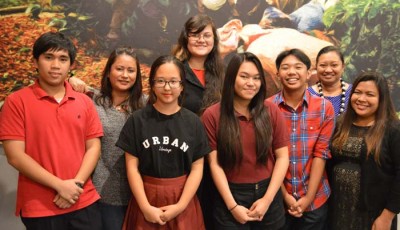Aeronautical Dolphins tweaking design

Members of the five-time Real World Design Challenge Pacific State champion Marianas High School Aeronautical Dolphins pose after receiving their medals and certificates from RWDC Real World WDC state coordinator Jennifer Cubangbang, standing left, and MHS vice principal Karen Alla, standing right. (Jon Perez)
The Marianas High School Aeronautical Dolphins are making slight changes on the design of their entry to the Real World Design Challenge national finals set from April 21 to 23 in Washington, D.C. They aim to leave Saipan in the third week of April and arrive on the 20th.
Project manager Ann Margaret Norcio said they are working doubly hard in order to finish the final design that they would present against the other state champions.
“We’re working during recess and until around 6pm after school. We’re working on everything and now updating the aircraft design,” said Norcio, who together with the other members of the team and coach John Raulerson received their certificates and medals from RWDC state coordinator Jennifer Cubangbang yesterday at the MHS Counseling Office.
The team—composed of marketing specialist Edna Nisola, project mathematician Masrur Alam, simulations engineer Jun Young Kim, mission planner Matthew Cao, aircraft design engineer Robert Malate, and systems planner Daniel Villarmero—had only two months left to finalize everything.
“Talk about time pressure. Compared to last year where we had six months to prepare. We’re working on how the aircraft can do more, where it can cover two fields aside from one. It would lessen the time but double the productivity,” said Norcio.
She added that last year their design was among the top two that was picked by the organizers to have a model displayed in Washington. “It would really be cool to one day see our design working in the real world.”
The Aeronautical Dolphins will again represent the Pacific States—American Samoa, the CNMI and Guam—for the fifth straight year after winning the 2016 RWDC Pacific State Championship last Jan. 8 since joining in 2012.
Education Commissioner Dr. Rita A. Sablan, in an email sent to Rep. Gregorio Kilili C. Sablan (Ind-MP), said that they approved to shoulder the $10,000 needed to support the travel costs of the team. The fund will come from the student competition program through the consolidated grant.
Their entry, called the Cruiser, is a small and unmanned aircraft that uses current technology to perform moisture detection on crops would be up against other state winners in the nationals.
RWDC is an annual competition for high school students, grades 9 to 12, where they work on real world engineering challenges. The winning team earns a $50,000 scholarship from Embry-Riddle Aeronautical University.
























